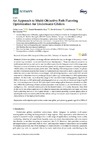Identificador persistente para citar o vincular este elemento:
https://accedacris.ulpgc.es/jspui/handle/10553/60155
| Título: | An approach to multi-objective path planning optimization for underwater gliders | Autores/as: | Lucas, Carlos Hernández-Sosa, Daniel Greiner, David Zamuda, Aleš Caldeira, Rui |
Clasificación UNESCO: | 331913 Vehículos submarinos 120304 Inteligencia artificial 120326 Simulación |
Palabras clave: | Multi-objective optimization Underwater glider Path planning Genetic algorithm NSGA-II |
Fecha de publicación: | 2019 | Publicación seriada: | Sensors | Resumen: | Underwater gliders are energy-efficient vehicles that rely on changes in buoyancy in order to convert up and down movement into forward displacement. These vehicles are conceived as multi-sensor platforms, and can be used to collect ocean data for long periods in wide range areas. This endurance is achieved at the cost of low speed, which requires extensive planning to ensure vehicle safety and mission success, particularly when dealing with strong ocean currents. As gliders are often involved on missions that pursue multiple objectives (track events, reach a target point, avoid obstacles, sample specified areas, save energy), path planning requires a way to deal with several constraints at the same time; this makes glider path planning a multi-objective (MO) optimization problem. In this work, we analyse the usage of the non-dominated sorting genetic algorithm II (NSGA-II) to tackle a MO glider path planning application on a complex environment integrating 3D and time varying ocean currents. Multiple experiments using a glider kinematic simulator coupled with NSGA-II, combining different control parameters were carried out, to find the best parameter configuration that provided suitable paths for the desired mission. Ultimately, the system described in this work was able to optimize multi-objective trajectories, providing non dominated solutions. Such a planning tool could be of great interest in real mission planning, to assist glider pilots in selecting the most convenient paths for the vehicle, taking into account ocean forecasts and particular characteristics of the deployment location. | URI: | https://accedacris.ulpgc.es/handle/10553/60155 | ISSN: | 1424-8220 | DOI: | 10.3390/s19245506 | Fuente: | Sensors [ISSN 1424-8220],v. 19 (24), 5506 |
| Colección: | Artículos |
Citas SCOPUSTM
18
actualizado el 08-jun-2025
Citas de WEB OF SCIENCETM
Citations
17
actualizado el 08-jun-2025
Visitas
206
actualizado el 30-nov-2024
Descargas
171
actualizado el 30-nov-2024
Google ScholarTM
Verifica
Altmetric
Comparte
Exporta metadatos
Los elementos en ULPGC accedaCRIS están protegidos por derechos de autor con todos los derechos reservados, a menos que se indique lo contrario.
